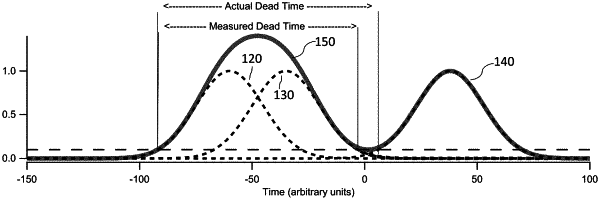| CPC G01T 1/171 (2013.01) [G01N 15/0205 (2013.01); G01N 15/0211 (2013.01); G01N 15/065 (2013.01); G01N 15/1459 (2013.01); G01T 1/172 (2013.01)] | 20 Claims |

|
1. A method for detecting particles, comprising:
directing a flow of gas or liquid containing particles through a sensing region illuminated by a light source;
detecting light scattered by the particles as they pass through the sensing region, the detecting comprising capturing a light intensity signal comprised of multiple pulses above a threshold level, each pulse comprising in indication of light scattered by one or more particles;
counting distinct pulses during a measurement period, each distinct pulse the signal crossing from below the threshold level to above the threshold level;
measuring a measured live time over the measurement period, the measured live time comprising a length of time the signal is below the threshold level; and
outputting a coincidence-corrected value comprising a number of particles that passed through the sensing region during the measurement period, the coincidence-corrected value calculated by dividing a number of distinct pulses counted by a first quantity, the first quantity comprising the measured live time, minus a second quantity, the second quantity comprising a constant multiplied by the number of distinctly counted pulses, where the constant is determined by comparing the number of distinct pulses against a number of distinct pulses in a known concentration to derive a mean time period added to each distinct pulse before detecting a next particle as a distinct event and has the units of time.
|